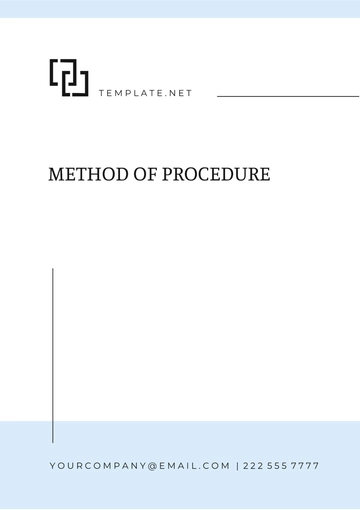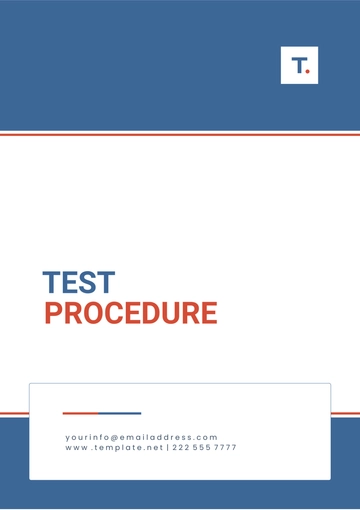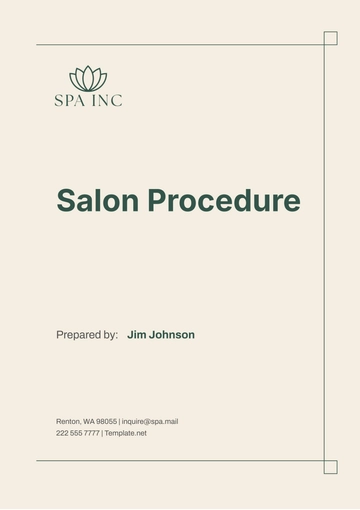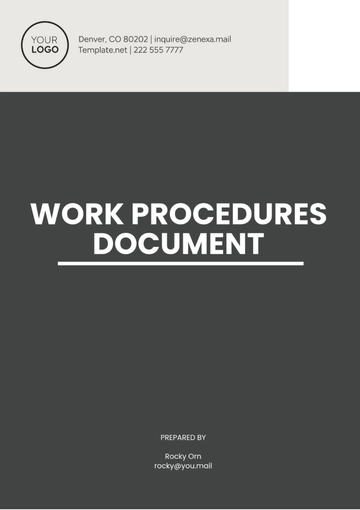Free Car Rental Work Safety Procedure

I. Introduction
A. Purpose
The purpose of this Work Safety Procedure is to outline the work procedures necessary to ensure the safety of all employees at [Your Company Name]. It is imperative that all staff members adhere to these guidelines to maintain a safe and secure working environment.
B. Scope
This procedure applies to all employees of [Your Company Name], including full-time, part-time, temporary, and contract staff. It covers all activities related to car rental operations, including vehicle maintenance, customer service, and office work.
C. Responsibilities
Management: Ensure all safety procedures are in place and followed. Provide necessary training and resources to employees.
Employees: Adhere to all safety guidelines and procedures. Report any unsafe conditions or incidents to management immediately.
Safety Officers: Monitor compliance with safety procedures. Conduct regular safety inspections and training sessions.
II. Workplace Safety Guidelines
A. General Safety Rules
All employees must follow these general safety rules to prevent accidents and injuries in the workplace.
Personal Protective Equipment (PPE): Always wear appropriate PPE, such as gloves, safety glasses, and high-visibility vests, when handling vehicles or hazardous materials.
Housekeeping: Keep work areas clean and free of hazards. Ensure all tools and equipment are stored properly when not in use.
Emergency Procedures: Familiarize yourself with emergency exits, fire extinguishers, and first aid kits. Participate in regular emergency drills.
Reporting Hazards: Report any unsafe conditions or potential hazards to your supervisor immediately. Do not attempt to fix hazards yourself unless trained and authorized to do so.
Ergonomics: Use proper lifting techniques and ergonomic tools to prevent musculoskeletal injuries. Adjust workstations to fit your body and reduce strain.
B. Vehicle Handling Safety
Employees handling vehicles must adhere to these safety procedures to prevent accidents and injuries.
Vehicle Inspection: Perform a thorough inspection of the vehicle before use. This includes checking for any visible damage, fluid leaks, and tire condition to ensure the vehicle is safe for operation.
Safe Driving Practices: Always follow traffic laws and company driving policies. Avoid distractions and ensure seat belts are worn at all times to prevent accidents.
Loading and Unloading: Use proper techniques and equipment when loading and unloading vehicles. This helps avoid overloading and ensures that loads are secure, reducing the risk of accidents.
Maintenance Procedures: Follow established procedures for vehicle maintenance. Only qualified personnel should perform repairs and servicing to maintain vehicle safety.
Parking and Storage: Park vehicles in designated areas and ensure they are locked when not in use. Follow company protocols for vehicle storage and security to prevent theft or damage.
III. Hazard Communication
A. Identifying Hazards
Employees must be able to identify potential hazards in the workplace and take appropriate action to mitigate them.
Chemical Hazards: Recognize and understand the risks associated with chemicals used in vehicle maintenance. Refer to Safety Data Sheets (SDS) for detailed information.
Physical Hazards: Be aware of physical hazards such as moving vehicles, sharp objects, and slippery surfaces. Take steps to avoid these hazards.
Ergonomic Hazards: Identify ergonomic risks, such as repetitive motions or improper workstation setup. Use proper techniques and equipment to reduce these risks.
Biological Hazards: Understand the risks of exposure to biological hazards, such as bloodborne pathogens. Follow company protocols for handling and disposal.
Environmental Hazards: Recognize environmental hazards, such as extreme weather conditions. Take appropriate precautions to ensure safety.
B. Hazard Communication Program
The following table outlines the key components of our Hazard Communication Program:
Component | Description |
|---|---|
Labeling | Ensure all hazardous materials are properly labeled with clear identification. |
Safety Data Sheets (SDS) | Maintain accessible SDS for all hazardous chemicals used in the workplace. |
Training | Provide regular training on hazard communication and safe handling practices. |
Emergency Procedures | Establish and communicate procedures for responding to hazardous material incidents. |
Labeling: Proper labeling is crucial to ensuring that employees can quickly identify hazardous materials and understand the associated risks. Labels should include the name of the chemical, hazard warnings, and the manufacturer's information. This helps in preventing accidental exposure and misuse of hazardous substances.
Safety Data Sheets (SDS): SDS provide detailed information on the properties, hazards, and safe handling of chemicals. They are essential for educating employees about the risks associated with chemical use and the measures to take in case of an emergency. Ensuring that SDS are readily accessible helps employees make informed decisions and take appropriate actions to maintain safety.
Training: Providing regular training on hazard communication and safe handling practices is vital. Training ensures that employees are knowledgeable about the potential hazards they may encounter and the correct procedures to follow. Continuous education helps in reinforcing safety practices and keeping employees updated on new regulations or changes in procedures.
Emergency Procedures: Establishing and communicating procedures for responding to hazardous material incidents is essential for preparedness. Employees must know what actions to take in case of an emergency, such as spills or exposure, to minimize risks and ensure a swift and effective response.
An effective Hazard Communication Program is integral to maintaining workplace safety. By ensuring proper labeling, accessible SDS, regular training, and clear emergency procedures, we can mitigate risks associated with hazardous materials and promote a safe working environment.
IV. Emergency Procedures
A. Fire Safety
Employees must be prepared to respond effectively in case of a fire emergency.
Fire Alarms: Know the location of fire alarms and how to activate them in case of a fire. Ensure that fire alarms are functional and regularly tested.
Fire Extinguishers: Be familiar with the location and use of fire extinguishers. Only attempt to use a fire extinguisher if you are trained and it is safe to do so.
Evacuation Routes: Identify and use the nearest evacuation routes during a fire emergency. Participate in regular fire drills to practice evacuation procedures.
Assembly Points: After evacuating the building, proceed to the designated assembly points. Do not re-enter the building until it has been declared safe by emergency personnel.
Emergency Contacts: Keep a list of emergency contacts readily available. Notify the appropriate authorities and management in case of a fire.
B. First Aid
First aid procedures must be followed to provide immediate assistance to injured employees.
First Aid Kits: Know the location of first aid kits and their contents. Ensure that kits are fully stocked and regularly inspected.
CPR and AED: Be trained in CPR and the use of Automated External Defibrillators (AED). Provide assistance in case of cardiac emergencies.
Injury Reporting: Report all injuries, no matter how minor, to your supervisor immediately. Complete an incident report for record-keeping and follow-up.
Medical Assistance: Seek medical assistance for serious injuries or illnesses. Follow company protocols for emergency medical care.
Follow-Up Care: Ensure that injured employees receive appropriate follow-up care. Maintain communication with injured employees to support their recovery.
V. Vehicle Maintenance Safety
A. Maintenance Procedures
The following table provides an overview of the key steps in vehicle maintenance safety procedures:
No. | Step | Description |
|---|---|---|
1 | Preparation | Gather tools, equipment, and PPE needed for maintenance tasks. |
2 | Inspection | Perform a thorough inspection of the vehicle to identify maintenance needs. |
3 | Repair | Conduct necessary repairs following safety protocols and manufacturer guidelines. |
4 | Testing | Test the vehicle to ensure repairs are effective and safe. |
5 | Documentation | Record maintenance activities and outcomes in the maintenance log. |
Preparation: Before starting any maintenance task, it is important to gather all necessary tools, equipment, and personal protective equipment (PPE). This ensures that the job can be completed safely and efficiently without interruptions or the need to search for missing items.
Inspection: A thorough inspection of the vehicle helps identify any issues that need attention. This step is crucial for detecting potential problems early and preventing them from becoming major safety hazards. Employees should be trained to conduct inspections systematically and report any findings promptly.
Repair: Conducting necessary repairs following safety protocols and manufacturer guidelines ensures that vehicles are maintained correctly. This step minimizes the risk of malfunction and enhances the safety and reliability of the vehicles.
Testing: Testing the vehicle after repairs ensures that all issues have been addressed effectively. It is essential to verify that the vehicle is functioning correctly and safely before it is returned to service.
Documentation: Recording maintenance activities and outcomes in the maintenance log is crucial for tracking the history of the vehicle’s condition. Proper documentation helps in future diagnostics and ensures that all maintenance tasks are accounted for and reviewed.
Following these maintenance procedures is vital for ensuring the safety and longevity of the vehicles. Regular and systematic maintenance helps prevent accidents and ensures that vehicles are always in optimal condition for use.
B. Safety Precautions
Employees must follow these safety precautions during vehicle maintenance tasks.
PPE Usage: Always wear appropriate PPE, such as gloves, safety glasses, and protective clothing, when performing maintenance tasks. PPE helps protect against chemical exposure, cuts, and other injuries.
Tool Safety: Use the correct tools for each task and ensure they are in good condition. Inspect tools regularly for damage and replace them if necessary.
Lifting Techniques: Use proper lifting techniques and equipment to avoid musculoskeletal injuries. Get assistance when lifting heavy objects.
Chemical Handling: Follow safe handling procedures for chemicals used in maintenance. Refer to SDS for information on proper use and emergency measures.
Vehicle Support: Ensure vehicles are properly supported and stabilized before working underneath. Use jack stands and other supports as necessary.
VI. Office Safety
A. Ergonomics
To prevent workplace injuries, employees should adhere to ergonomic practices.
Workstation Setup: Arrange workstations to minimize strain. Adjust chairs, monitors, and keyboards to fit individual needs and promote proper posture.
Breaks: Take regular breaks to reduce strain and fatigue. Stretch and move around periodically to maintain circulation and prevent muscle stiffness.
Equipment Use: Use ergonomic equipment such as adjustable chairs, monitor stands, and keyboard trays. These tools help maintain a comfortable and safe working environment.
Posture: Maintain proper posture while sitting and working. Keep feet flat on the floor, back straight, and wrists in a neutral position.
Lighting: Ensure adequate lighting to reduce eye strain. Use task lighting for specific activities and adjust screen brightness to comfortable levels.
B. Electrical Safety
Employees must follow these guidelines to ensure electrical safety in the office.
Equipment Inspection: Regularly inspect electrical equipment for damage or wear. Report any issues to maintenance personnel immediately.
Proper Use: Use electrical equipment according to manufacturer instructions. Avoid overloading outlets and using damaged cords or plugs.
Cords and Cables: Keep cords and cables organized and away from walkways to prevent tripping hazards. Use cable management solutions to maintain a tidy workspace.
Emergency Procedures: Know the location of circuit breakers and how to shut off power in an emergency. Follow company protocols for electrical emergencies.
VII. Customer Interaction Safety
A. Customer Service Protocols
Employees must follow these protocols to ensure safe and effective customer interactions.
Greeting Customers: Greet customers warmly and professionally. Maintain a friendly demeanor while following safety guidelines.
Customer Identification: Verify customer identification before processing rentals. Ensure that the provided information matches company records.
Vehicle Handover: Explain vehicle features and safety instructions to customers. Ensure they understand the operation of the vehicle before leaving.
Payment Handling: Follow secure payment handling procedures. Verify payment information and provide receipts for all transactions.
Customer Feedback: Encourage customers to provide feedback on their rental experience. Address any concerns promptly and professionally.
B. Conflict Resolution
Employees should be prepared to handle conflicts with customers effectively and safely.
Stay Calm: Remain calm and composed during conflicts. Avoid escalating the situation by maintaining a professional demeanor.
Listen Actively: Listen to the customer’s concerns without interrupting. Show empathy and understanding to diffuse tension.
Seek Solutions: Work with the customer to find a mutually acceptable solution. Offer alternatives and explain company policies clearly.
Escalate When Necessary: If unable to resolve the conflict, escalate the issue to a supervisor. Ensure the customer knows that their concerns are being taken seriously.
VIII. Training and Education
A. Training Programs
Employees must participate in regular training programs to stay updated on safety procedures.
Orientation: New employees must complete a safety orientation program. This includes an overview of company policies, emergency procedures, and workplace safety guidelines.
Ongoing Training: Participate in regular safety training sessions. These sessions cover topics such as hazard communication, emergency response, and vehicle handling safety.
Specialized Training: Employees performing specific tasks, such as maintenance or hazardous material handling, must complete specialized training programs. This ensures they have the necessary skills and knowledge to perform their duties safely.
Refresher Courses: Attend refresher courses periodically to reinforce safety practices. These courses help keep safety knowledge current and address any changes in procedures.
B. Safety Meetings
Regular safety meetings help maintain a focus on workplace safety and allow employees to discuss concerns.
Monthly Meetings: Attend monthly safety meetings to discuss recent incidents, share safety tips, and review procedures. Participation in these meetings is mandatory for all employees.
Incident Reviews: Review recent safety incidents and near-misses during safety meetings. Discuss causes and preventive measures to avoid future occurrences.
Employee Input: Encourage employees to provide input and suggestions during safety meetings. This helps identify potential hazards and improve safety practices.
Action Plans: Develop action plans based on safety meeting discussions. Assign responsibilities and set deadlines for implementing safety improvements.
IX. Review and Update
A. Procedure Review
Frequency of Review: This safety procedure will be reviewed annually by the management team at [Your Company Name]. Annual reviews ensure that our safety protocols remain current and effective in addressing evolving risks and operational changes.
Feedback Integration: Feedback from employees regarding the practical application of safety measures will be solicited during these reviews. This input helps in identifying areas for improvement and ensuring that the procedure is practical and relevant.
Communication of Updates: Any updates resulting from the annual reviews will be promptly communicated to all employees. Clear communication and training sessions will be conducted to ensure understanding and compliance with revised procedures.
Continuous Improvement: The review process aims to foster continuous improvement in our safety culture. It allows us to stay proactive in enhancing workplace safety and maintaining compliance with industry standards.
B. Incident Analysis and Learning
Incident Analysis Process: Incidents and near-misses will be analyzed comprehensively to identify root causes and prevent recurrence. This analysis involves input from safety officers, supervisors, and affected employees.
Improvement of Safety Measures: Findings from incident analyses will guide the enhancement of safety measures and procedures where necessary. Lessons learned will be integrated into our safety practices to mitigate risks effectively.
Integration into Procedures: The proactive approach of incident analysis ensures that learnings are incorporated into ongoing safety protocols. This integration strengthens our ability to prevent future incidents and maintain a safe work environment.
Continuous Learning: By learning from incidents, we reinforce a culture of continuous learning and improvement. It underscores our commitment to prioritizing safety and protecting the well-being of our employees and customers.
C. Training and Awareness
Annual Training Sessions: Annual training sessions will be conducted to reinforce safety protocols, educate new hires, and refresh existing employees on best practices. Training topics will include hazard recognition, emergency response, and proper use of PPE.
Tailored Training: Training sessions will be tailored to address specific roles and responsibilities within our organization. This approach ensures that each employee receives relevant and actionable safety information.
Awareness Campaigns: Ongoing awareness campaigns, such as posters, newsletters, and safety reminders, will promote a culture of safety throughout the company. These initiatives keep safety top-of-mind and encourage proactive safety behaviors.
Empowering Employees: By prioritizing training and awareness, we empower employees with the knowledge and skills to maintain a safe workplace. This proactive approach enhances safety outcomes and contributes to a strong safety culture company-wide.
- 100% Customizable, free editor
- Access 1 Million+ Templates, photo’s & graphics
- Download or share as a template
- Click and replace photos, graphics, text, backgrounds
- Resize, crop, AI write & more
- Access advanced editor
Ensure employee safety with the Car Rental Work Safety Procedure Template from Template.net! This customizable template provides a comprehensive framework for a safety procedure. The editable format allows you to include specific safety protocols relevant to your business. With the AI Editor Tool, create a detailed safety procedure with ease!





























